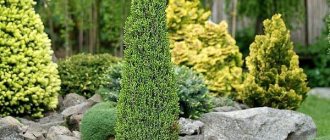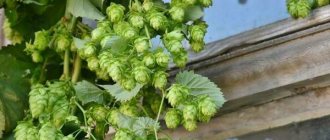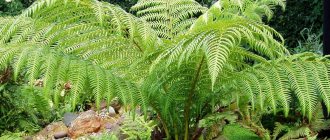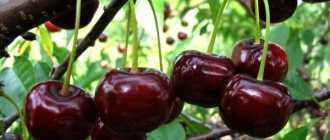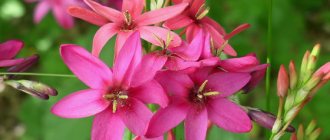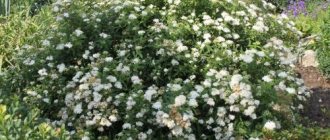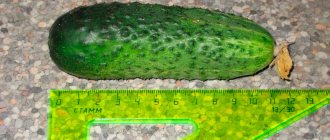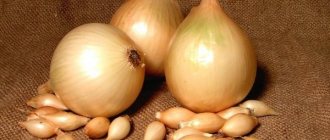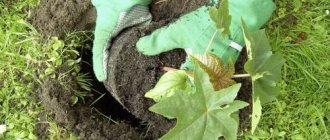Description of the plant
Arabis is used as a herbaceous ground cover.
Low shoots tend to grow and take over adjacent areas. The shoots rise above the ground surface to a height of 10-30 cm. The stems and leaves are covered with hard pile. The leaf blade is heart-shaped.
Photo of Arabis plant
The inflorescences are small, up to 15 mm in diameter, and can be simple or double. Racemose flowers can be white, red, yellow, or purple. The flowering period of Arabis is quite long, beginning in mid-spring.
A significant number of flowers emit fragrance. The plant is a honey plant that hardworking insects do not ignore. The fruit is a pod in which the seeds ripen.
Arabis (Rezuha) - video
Description and features of Arabis
In appearance, it is a creeping grass with a height of up to 30 cm. The ground cover stems, which easily take root, have heart-shaped leaves. Small flowers are collected in neat compacted tassel-type inflorescences.
Various colors: pink, white, purple, yellow. It blooms for a long time and festively, exuding an aroma that attracts a huge number of insects. Like all cruciferous plants, after flowering a fruit is formed in the form of a pod; the seeds are flat in shape; in some types of Arabis they are winged.
The conditions for growing the plant are absolutely simple, so it is very popular among gardeners for use in decorating flower beds.
Arabis: planting and caring for the plant
The plant does not have any special requirements for growing conditions. But you still need to take into account recommendations for the landing site and soil requirements.
Arabis seeds are often flat-shaped, but there are varieties in which the planting material is endowed with wings.
Before planting rhizomes in open ground (at the end of May), you should note whether the shoots have 3 full plates.
Select a place for the plant that is sunny with access to fresh air. Arabis can grow in partial shade, but flowering will not be abundant.
Photo of planting rhizomes in open ground
The soil is preferably loose, with the addition of sand and stones. Places where there is stagnant moisture are not recommended. The Arabis plant can grow in poor soils, but remarkable flowering and rapid growth of green mass cannot be expected. The recommended planting pattern is 40cm*40cm. You can plant 3-4 plants at once in one planting hole.
Good to know!
In addition to watering, after a few days, the planted plant can be fertilized with complex fertilizers. Arabis grown from seeds will bloom only in the second year of life.
Planting and care of Arabis - video
There are no special features in caring for the rhizome. Everything is traditional - moistening, fertilizing, removing weeds, loosening the soil. To rejuvenate the stems, immediately after the arabis flowers, the green mass should be cut off by 1/3. Like most ground cover plants, rezuha is resistant to short-term drought. It is better to leave Arabis without watering for a while rather than overdo it with moisture.
Until the young plant gains strength, it must be protected from the aggression of weeds. But as soon as the rhizome grows, it will be able to fend for itself. To give the plant a neat shape, it is possible to remove faded flowers and stems.
Botanical description
Arabis flowers are grown as annual and perennial ground cover plants with rooting creeping stems. Arabis can reach a height of 30 cm. The leaves of the rhizome are green, densely pubescent, entire, heart-shaped, sometimes jagged along the edges. Pink, white, lilac or yellowish flowers, simple or double, up to 1.5 cm in diameter, are collected in small but dense racemes. The lush and long-lasting flowering of Arabis, which begins in the second half of spring, is accompanied by a pleasant aroma, to which bees flock en masse. The fruit of the rhizome is a pod with flat seeds, which in some species are winged.
Relatives of Arabis are plants such as alyssum, horseradish, rapeseed, cabbage, mustard, Iberis, radish and other cruciferous crops. In addition to its strong aroma, rezuha is undemanding to growing conditions, so planting and caring for Arabis in the open ground is not a burdensome and enjoyable task.
Arabis plant propagation
You can quickly start a rhinestone in your flowerbed by cuttings, root division, or using layering.
Growing and caring for Arabis - video
Reproduction of rhizomes - vegetative method
Arabis of rare varieties is often propagated using cuttings.
It is necessary to separate the cutting with the “heel” from the bush, where the root system is subsequently formed from the cambial layer of the shoot. This process must be started after the Arabis flowering. As a cutting, you can use the apical part of a shoot 10 cm long, from which all the leaves in the lower part are removed.
Photos of rhizome cuttings
The Arabis cuttings are immersed in loose soil at an angle (45 degrees) and covered with a transparent container. The improvised greenhouse is sent to a warm, bright place, without direct sunlight. In order not to provoke rotting and the formation of fungus, the greenhouse should be ventilated. The soil is kept moist until the cuttings take root.
GROUND COVER PLANT!
Subulate Phlox
Arabis propagation by layering
To obtain an Arabis plant using layering, you will need to select a strong shoot and pin it to the ground.
But first, in the place of fixation, it is necessary to make a depression, place part of the shoot into it, sprinkle it with soil and build a bend.
The top of the pinned shoot is pinched.
Photo of propagation by layering
After the shoot has formed roots, it can be separated from the mother plant and transplanted to a permanent place of growth. So, without resorting to removing the plant from the ground, you can get several new Arabis specimens for planting in another place.
BEAUTIFUL FLOWERS!
Wisteria Calceolaria FLOWERS ICSIA
Arabis: propagation by root division
Dividing the bush is the most successful method of propagating Arabis. It is recommended to use it if you want to preserve a rare plant variety.
The bush is removed from the ground, lightly shaken and divided into full-fledged divisions that can quietly develop in the future.
Growing Arabis from seeds
Arabis is a plant that can easily be propagated by seed.
Seed material can be easily purchased at specialized stores, exhibitions or garden centers.
Photo of Arabis from seeds
A simple way is to sow Arabis seeds in open ground in the fall.
To propagate rhizomes by seedlings, sowing is carried out in mid-spring.
To do this, soil is poured into containers with the addition of sand or small stones. The composition of the soil should be 3/1. The seeds are immersed 5 mm in moistened soil. The containers are placed in a warm place where the plant will have optimal conditions. It is recommended to cover containers with seeds with non-woven material.
When shoots appear after 25 days, the canvas is removed from the containers and watering is reduced. There comes a time when plants need not only warmth, but also natural light. Next, the seedlings are provided with regular watering and loosening.
Picking is done after the appearance of a full-fledged leaf.
There is a reason for picking if Arabis is planned to be grown in a container as a separate plant.
If the rezuha is assigned the role of a ground cover plant, then there is no need for picking.
Approximately 10 days before planting Arabis in open ground, the plants must be hardened and adapted to environmental conditions. This should be done gradually.
Planting Arabis in open ground
When to plant
Planting Arabis, or planting rhizomes in the ground, is carried out at the beginning of June or at the end of May, but not before the seedlings develop three true leaves. They choose sunny, well-windowed areas for Arabis, although it grows well in partial shade, but it does not bloom so luxuriantly and does not grow so much.
How to plant
The soil on the site for Arabis should be loose, sandy, not too wet, well cultivated, cleared of weeds and fertilized with mineral and organic fertilizers. To increase moisture and air permeability, you can add sand, small pebbles and turf to the garden soil. But if you plant rhizome in calcified or poor acidic soil, it will also grow, although not as vigorously. Arabis planting scheme 40x40 cm. You can plant 3-4 seedlings in one hole.
Immediately after planting, the area is watered, and if fertilizers were not applied to the soil before planting, then literally a day or two after planting the Arabis, feed it with complex mineral fertilizer. Arabis blooms from seeds in the second year after planting.
Varieties of Arabis
Popular types of Arabis are:
- Alpine;
- Caucasian;
- brood-shaped;
- running out;
- breach;
- short;
- ciliate.
Arabis Arabisalpina
Alpine Arabis is native to Scandinavian countries.
It is also found in the mountainous regions of North America, the Far East and Western Europe. There wild plants reach 35 cm in height. The shoots do not die off in winter, but are pressed to the surface of the soil, forming clumps.
The leaf blades at the base are oval-shaped, and closer to the top they are heart-shaped. The inflorescences can be 5 cm long, and each flower is 1 cm. Flowers are white or pinkish in color. The flowering period begins at the end of April and lasts about 4 weeks.
Varieties of the alpine Arabis species: “Schreeshaube”, “Terry”, “Pink”.
Photo of the alpine species Arabis "Terry"
Photo of the alpine species Arabis "Pink"
Caucasian Arabis
Arabis caucasica is considered by some botanists to be a subspecies of the Alpine rhizome.
In the wild, it is found in the vast expanses of Central Asia, Crimea, the Mediterranean and the Caucasus. The height of the flowering plant can be 30 cm. The leaf blades are small in size and have an oval shape. There are serrations along the edge of the sheet, and the surface of the sheet plates is covered with pile.
Against the background of the gray-green color of the foliage, the inflorescences with white flowers look delicate. The flowering period begins in June and lasts 30 days.
Rare single flowering until autumn cannot be ruled out. The length of the inflorescences is 1.5 cm.
Garden varieties of Caucasian Arabis: “Flore-pleno”, “Veriegata”, “Rosabella”.
Photo of the Caucasian Arabis garden variety “Flore-pleno”
Photo of the garden variety of Caucasian Arabis "Rosabella"
Photo of the Caucasian Arabis garden variety “Veriegata”
Bruovoid arabis
Arabis bryoides grows wild in the mountainous regions of Greece, Bulgaria and Albania.
The plant is perennial and forms a cushion-shaped plant.
The height of the bushes is insignificant, only 10 cm. The leaf plates are oval in shape, collected at the rosette and covered with a hard edge. One loose inflorescence contains no more than 6 white flowers.
Arabis running out
Arabis procurrens is native to the Balkans.
The height of the plant in flowering state reaches about 12 cm. The leaf rosettes are pale.
This species is often used when planting elephants in alpine slides. The emerging species is frost-resistant and drought tolerant.
A popular variety of the species is Arabis "Veriegata"
with a white border along the leaf and purple flowers. It is notable for the fact that the inflorescences subsequently change color from purple to white.
Photo of Arabis "Veriegata"
Arabis prolomnikov
Arabis androsacea is a rare species that can be found on the Turkish slopes, at 2300 meters above sea level.
The plant is a perennial plant that prefers rocky soil.
The height of the bushes of Rezuha prolomnikov does not exceed 10 cm. The leaves have an oval-pointed shape. The inflorescences consist of a small number of simple white flowers.
Arabis lowgrowing
Arabis pumila is found in the Alps and Apennines.
The height of the bushes is rarely more than 15 cm. The low-growing Arabis species has modest and unremarkable white flowers.
The rezuha blooms at the end of May.
But this plant
has its own highlight - these are fruits that look very impressive.
Arabis cilifolia
Arabis blepharophylla grows relatively low in the wild in the mountains of California.
At an altitude of 500 m above sea level, you can find a perennial growing in a small group. A low plant (8 cm) attracts the eye with dark pink inflorescences and gray-green foliage.
The ciliated type of rhizome is popular among flower growers. Breeders have developed several varieties of this Arabis that are in demand: “Rout Sensation”, “Frühlingshaber”, “Arabis Ferdinand”.
Arabis after flowering
How and when to collect seeds
During flowering, select the most beautiful Arabis inflorescences and mark them. Seeds should be collected after the first frost, on a dry, sunny day, since seeds collected in wet weather have low germination. Cut off the inflorescences with part of the stem and dry them in a dry, well-ventilated room hanging, then remove the seeds and store them in a cardboard box in a dark, dry place.
Preparing for winter
Arabis can withstand cold down to -5-7 ºC, but in stronger frosts it dies without shelter. With the onset of winter, Arabis shoots are cut off, leaving only 2-4 cm above the surface, which are covered with dry leaves, spruce branches or covering material.
Pests and diseases
Arabis is a plant that can resist many diseases and pests.
But rhizomes do not have 100% immunity.
ANNUAL FLOWERS!
The most unpretentious annual flowers
The Arabis plant can suffer from cruciferous flea beetle and viral mosaic. The appearance of brown spots on the leaf blade is a signal for action and protection against viral mosaic. In this case, the damaged shoots are removed, and the soil is treated with a solution of potassium permanganate. If the extent of the damage is significant, then after treatment you should not grow anything in this place for 1 year.
For cruciferous flea beetles, drugs such as “Aktara”, “Aktellik”, “Iskra”, “Karbofos”, “Biotlin” will be effective.
Arabis: combination with other plants
Perennial Arabis fits perfectly into any flower arrangements and greenhouses, ideally complements terraces and modern architectural solutions made of stone. Unpretentious bushes look very impressive next to scarlet tulips, noble irises, extraordinary alyssum and other early flowering bulbous crops. Low-growing varieties are usually used to create a picturesque background in a rose garden.
Arabis in the flowerbed
Lush mountain plants are most often used to decorate rock gardens and rockeries; they decorate any rocky walls and structures. Perfect for arranging mixborders and decorating borders, strengthening slopes and creating bright accents in a personal plot.
How to collect Arabis seeds
During the flowering period, spectacular inflorescences are noticed on the bushes, which are suitable for propagation.
They should be noted.
You can tie them with colored thread. As soon as the first cold weather arrives, you should start collecting seeds. The weather should be dry. The process occurs as follows: the marked shoots are cut off and sent to a dry place to dry. Then the seeds are removed from the seed pods and stored until next year.
Before wintering, the rezuha does not need special measures in regions with a warm climate. Where there is a significant drop in temperature, Arabis must be cut and covered with dry foliage or spruce branches on top. This will protect the plant from freezing.
Mr. Summer Resident recommends: Arabis in landscape design
The humble plant is popular for its versatile uses. The ground cover shrub is unpretentious and is characterized by rapid growth, therefore, in a short period of time, it creates green corners where many other plants are not able to develop. He is comfortable in the flowerbed, between the trees and bushes in the garden. Not only are the tassels of flowers remarkable, but also the carved, pubescent foliage.
Very often Arabis is used when landscaping an alpine hill, where it thrives between stones. Strong roots penetrate deep into the soil, and rezuha planted in a dry place can decorate it.
When planting, you should remember about the Arabis' love for the sun and light. In a illuminated area, the bushes are more decorative and the flowering is brighter. In the shade, the plant noticeably stretches out. When planting in flower beds, take into account that arabis looks good in group plantings among low-growing perennials, as well as marigolds, calendula, nasturtium, and alyssum.
Tips for using Arabis in garden design
The perennial Arabis flower fits well in rockeries, dry streams or stone walls. The foliage is especially effective when rising over rocks or cascading over walls.
The flowers form a dense, creeping mat, excellent for mountain gardens, retaining walls, steep banks and as a ground cover for poor, dry, sunny areas. The "carpet" of flowers contrasts beautifully with larger, richer or more upright perennials. Rezuha also looks good in mixborders and various kinds of flower beds. An excellent option would be to plant the plant along the edges of a flower bed or flower garden.
Arabis Ferdinanda photo
Arabis Ferdinanda is a very low species, the height of its representatives is up to 5 cm. With such a height of the bush, it is valued for its attractive green foliage with white edges and long flowering. The flowers are small, white or pinkish. During flowering, a lush cushion of leaf rosette is abundantly covered with white flowers. Flowering is very long.
Transplanting Arabis
The hardy rhizome normally tolerates transshipment to a new place if all stages of the agrotechnical operation are carried out correctly. The plant has numerous thin roots, which are easily damaged if handled carelessly, so it is better to remove it with a lump of soil. The main stages of the technology for transplanting Arabis are as follows:
- When preparing holes, the roots of perennial weeds are carefully removed.
- You can sprinkle a thin layer of small pieces of broken brick at the bottom of the hole.
- Cover the drainage with a fertile layer of soil up to 25 cm thick.
- First, water the holes a little so that planting is done in moist soil.
- Loosen the substrate around the bush and remove the rhizomes.
- The soil around the roots should not be shaken off.
- Transfer the Caucasian Arabis into the prepared hole.
- Fill the hole, compact the substrate a little and water it.
Diseases and pests of Arabis
The main danger to the rhizome is the cruciferous flea beetle. Dusting ground cover bushes with ash is a labor-intensive task, so in open flower beds it is better to spray with Aktara, Actellik, Biotin or Iskra. The Caucasian Arabis flower is very resistant to diseases. The most unpleasant misfortune for this culture is mosaic. The disease is distinguished by brown spots that gradually merge. Mosaic cannot be cured. Infected bushes are removed from the flowerbed and burned.
5.Reproduction
There are many ways to propagate Arabis and all of them are not particularly difficult. The choice of a specific method will depend on the species and varietal characteristics of the flower.
Species plants can be safely propagated by seeds - the daughter bushes thus obtained will exactly match the appearance of the parents.
Varietal plants, when propagated by seed, lose their attractiveness and declared characteristics - they are propagated by any vegetative means - division, air layering, stem and leaf cuttings.
Terry varieties do not form seeds at all after flowering.
↑ Up,
5.1.Growing from seeds
Sowing seeds is carried out both directly in open ground, before winter, and at home in early April - for seedlings.
When sowing in winter, it is worth choosing the timing so that the first shoots do not have time to appear before the onset of frost. Shoots usually appear together.
↑ Up,
5.1.1.Seed collection
In order to obtain planting material with good germination, it is necessary to allow the pods to fully ripen on the plants. The largest and most brightly colored flowers are selected for collection.
To prevent the pods from spontaneously opening and throwing the seeds to the ground, they are wrapped in gauze or a bandage in advance. They try to carry out the collection on fine, warm days.
The collected seeds are dried for several hours in a warm and well-ventilated place, spread out on sheets of paper. After drying, the seeds are placed in paper bags, stored and used as needed for 1 - 2 years.
↑ Up,
5.1.2.Sowing seeds
When sowing seedlings for growing Arabis, take special seedling boxes with transparent lids and make drainage holes on them. The first layer is drainage, and then the rest of the volume is filled with nutritious and loose soil, 1/3 consisting of river sand.
The seeds are sown evenly over the surface of the substrate and covered on top with a layer of earth about 5 mm thick.
The boxes are covered with lids or covered with non-woven material and placed in a fairly cool place with a temperature of about 18 degrees. The location should be brightly lit but out of direct sunlight.
↑ Up,
The shelter is removed daily for ventilation, gradually increasing the time. With the appearance of the first shoots, the shelter is completely removed.
The soil in the boxes is kept evenly moist, but not waterlogged, by spraying water from a spray bottle.
With the appearance of the first 1 - 2 true leaves, the plants are planted in individual cups or pots. Diving is carried out as carefully as possible, trying not to pick up the bushes along with a lump of earth and not to injure the long roots.
7 - 10 days after diving, the plants can be fed for the first time with nitrogen fertilizers in a very low concentration.
↑ Up,
5.2.Propagation by cuttings
Since many terry varieties do not form seeds, and in order to fully preserve the varietal characteristics of plants, vegetative propagation methods are used, including cuttings.
Arabis is cut from leaf or stem cuttings.
↑ Up,
5.2.1.Leaf cuttings
Leaf cuttings cannot be separated with scissors, but should definitely be torn off with your hands, slightly pulling the leaf down. With this method of separation, a small heel remains at the base of the petiole - the cambial layer on the outside of the shoot.
For rooting, use small flower pots filled with nutritious soil mixture. The leaf petiole is immersed in the soil just a few millimeters and the substrate is kept evenly moist.
After some time, young growth will be visible at the base of the leaf.
↑ Up,
5.2.2.Stem cuttings
Another method of cuttings is the use of stem cuttings - such cuttings are cut after flowering so that their length is 8 - 10 cm.
The lower leaves are removed to reduce moisture loss and the base is dusted with growth hormones. Immerse the cuttings in a moist substrate approximately 1 cm deep at a slight angle.
The tops of the pots are covered with a transparent plastic bag or glass to create a greenhouse effect and maintain high air humidity.
↑ Up,
Place the pots with cuttings in a well-lit place without direct sun access; the air temperature in such a room should be in the range from 18 to 22 degrees.
The cover is removed daily, ventilating the young bushes and wiping off any water condensation that appears. With the appearance of the first roots, the leaves become strong and elastic again, and new, young shoots appear at the base of the cutting.
↑ Up,
5.3. Reproduction by air layering
One of the simplest methods of propagation, which is carried out in late spring or early summer. The side shoots of Arabis are inclined to the surface of the earth, pinned and dug a little into the ground.
The top of the shoot should remain above the ground and should be pinched a little. The soil surface is always kept moist.
If you follow this agricultural technology, in a couple of weeks the first young leaves will appear from the buried part.
On each layer, several root systems can appear at once - according to the number of buried leaf nodes. When such a layer gets stronger, it is completely separated from the mother bush, divided into sections with separate roots and planted.
↑ Up,
5.4.Dividing adult plants
If necessary, in case of transplantation, you can divide the overgrown Arabis bushes into several parts.
Division is carried out after complete flowering - in the second half of summer. The bushes are dug out of the ground and the roots are shaken off from remaining soil.
The plants are cut into several sections with a sharp knife, making sure that well-developed roots and leaves remain in each piece.
The wound surface is sprinkled with crushed charcoal and the cuttings are planted in the desired location.
↑ Up,
5.5.Diseases and pests
Bushes that receive proper care rarely suffer from diseases; most often, fungi and viruses appear on weakened plants.
When a viral mosaic appears, the leaf blades acquire an uncharacteristic shade - plants affected by the virus cannot be treated. The bushes are dug up and destroyed; such specimens cannot be sent to the compost bin either. The area where the infected plant was found is watered with boiling water, in which quite a lot of potassium permanganate has been dissolved.
Sometimes downy mildew and rust appear.
Like most related plants, Arabis is susceptible to cruciferous flea beetle infestations. Of the small rodents, shrews can annoy plants.
↑ Up,
Arabis bruoid photo
Arabis bruoid is a low-growing, up to 10 cm, rezuha. Its small fluffy foliage forms rosettes, the flowers are white, collected in loose corymbs. The natural habitat of the Arabis bruidae is considered to be the territory of Albania, Bulgaria, and Greece.
The creeping stems are densely covered with small oval leaves, which are covered with whitish hairs.
The white flowers are collected in loose corymbose inflorescences, which consist of approximately 3-6 pieces.
